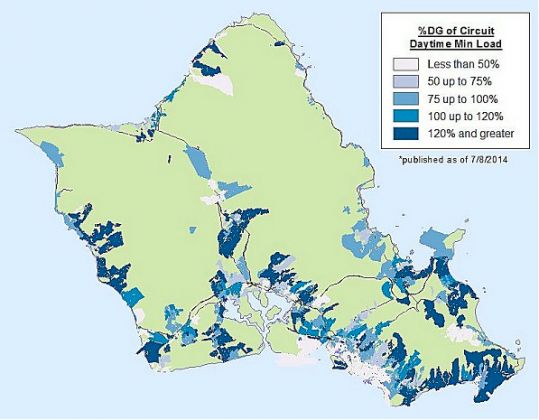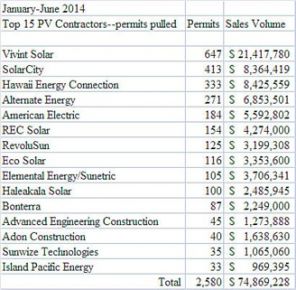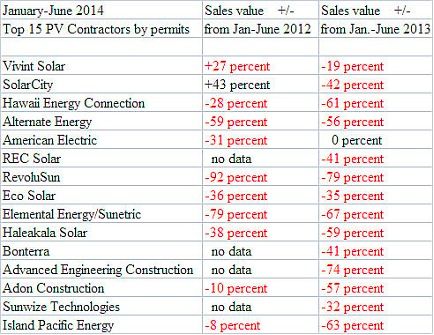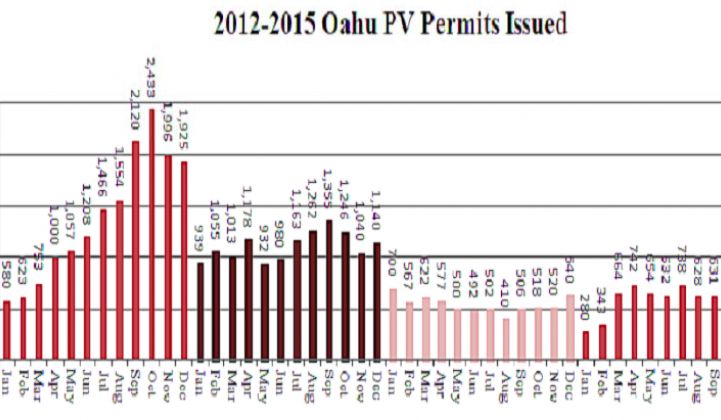Not long ago, the solar electric industry was the hottest construction trade on Oahu. Today, it is foundering.
According to January-June 2014 photovoltaic system permit data provided by the City and County of Honolulu Department of Planning and Permitting, the total number of PV permits issued dropped by 43 percent compared to the same period last year, and the total project value declined by more than 50 percent.
Riding high with white-hot annual growth from 2007 to 2012, few expected this ship to suddenly break apart at sea, with some of the top solar installation firms seeing their sales on the island drop off by more than 90 percent over the same period in 2013. Amidst talk of the Hawaiian Electric companies being under the gun, business models needing to change, an energy revolution happening before our eyes, so-called disruptive technologies emerging, and the manic search for readily available and affordable battery storage, many PV companies can’t afford to wait for this promised land of limitless distributed rooftop solar electric generation.
Last month marked the fourteenth straight month of year-over-year decline in the number of PV permits issued, with little hope of that trend reversing in the near term. Many of those companies that have come to rely on PV sales for the bulk of their revenue will find themselves in increasingly dire straits as the third and fourth quarters of the year will be little better than the first half of 2014. And, at least in the short-term, there’s very little that will be done to reverse this painful contraction.

In April, Governor Neil Abercrombie announced that Hawaii had “turned the corner” in its shift to renewable energy. “There is no turning back,” stated the governor as he stood flanked by the three PUC commissioners at the Capitol. Indeed, proclaimed Mr. Abercrombie, “the Rubicon has been crossed” in Hawaii: “The time for talk has ended, and the time for action is upon us.”
To what degree the state has turned the corner or passed some point of no return regarding renewable energy can be debated -- the governor took no questions after making these bold pronouncements. As far as solar PV on Oahu, it would seem that whatever corner turned may be leading to a dead end for many of the island’s top PV companies.
Why the decline?
What accounts for these almost uniformly grim numbers of significant decline, and what can be done about it? I posed these questions to top executives of the major PV players in the state and the current and former energy administrators at the Department of Business, Economic Development and Tourism (DBEDT). While some of the responses were more nuanced than others, the consensus was clear: all fingers point back to Hawaiian Electric Company.
Mark Glick, energy administrator at DBEDT, put it the most diplomatically: “Hawaii is clearly dealing with interconnection challenges as a result of high PV penetration that is occurring at levels found nowhere else in the country.” His predecessor Ted Peck suggested that the state is witnessing "the behavioral impact of...fear, uncertainty and doubt, [with HECO sowing] the seeds of hesitancy and delay in the minds of investors and purchasers of PV." According to Peck, “there are points of argument as to the proper speed of change. There is a benefit to a slowdown in rooftop PV adoption in that it buys the utility time to engineer bringing on more and for the decision-makers to get more comfortable with the reality of a distributed generation future.”
Bob Sumpf, general manager of American Electric’s PV division, believes “the decline is due almost totally to restrictions the utility has placed on the approval of PV systems for installation on so-called saturated circuits.”
Jae Kwak, CFO of Haleakala Solar, notes that “the decline in the industry is clearly due to the circuit breaker put into the net energy metering approval process.”
According to Hawaii Solar Energy Association (HSEA) executive director Leslie Cole-Brooks, there are fewer PV installations this year because of reduced grid access and “high penetrations of PV on an electrical system that the utility has not updated to accommodate renewables.”
Chris DeBone, managing partner of Hawaii Energy Connection and president of the HSEA, attributes the decline “not to the lack of public interest, but to a lack of foresight by the utility in managing the potential growth and popularity of distributed solar energy. On one hand, we should commend Hawaiian Electric for allowing the highest amount of PV per capita in the nation, but on the other hand, we were, without warning, lead to a cliff."
Joe Saturnia, president of Island Pacific Energy, attributes the decline in residential PV installations to two factors: the uncertainty and delays potential PV owners encounter when attempting to obtain an interconnect agreement from Hawaiian Electric, and the market becoming more and more saturated with PV.
How to allow for more rooftop PV on the island
Jon Yoshimura, SolarCity's director of government affairs in Hawaii, in accordance with Glick, Cole-Brooks and DeBone, notes the role that the PUC can play in directing HECO to upgrade the grid. DeBone and Saturnia assert that beyond engineering challenges around incorporating more solar PV, economic, social and fairness issues should also be in the discussion to make sure that PV does not continue to benefit those at the upper end of the economic ladder at the expense of those at the lower end.
Kwak goes where few in the industry tread as he questions the continued viability of net energy metering, noting that “the days of NEM may be numbered, and the industry needs to absorb this eventuality.” He further believes that “there must be sanctions placed against companies that have placed systems into service despite HECO’s rules. This is rogue activity that needs to be governed and regulated, and possibly prosecuted, because there is no place for this type of criminal/fraudulent activity.”
Urging the PV industry to lower its expectations, Yoshimura argues that “we will never go back to the gold-rush-type years we had in 2011 and 2012. It’s incumbent upon solar PV contractors to plan accordingly and set reasonable expectations for themselves, their employees, and their customers. Many companies are deploying new products (solar PV water heating, etc.) to cope with the drop in business; non-exporting and battery storage systems are also seen as potential solutions.”
PV penetration
Hawaiian Electric has 416 circuits across Oahu. As of last month, about 20 percent of them were in the 120+ percent daytime minimum load (DML) dark blue zone, and as such, little or no additional PV generation is being accepted in those service areas. About 23 percent of those circuits were in the 75 to 120 percent DML range, together account for a combined total of 43 percent of all HECO circuits. Moreover, the present level of PV capacity has implications for the whole island-wide grid, not just for particular circuits. Non-techno-speak translation: nearly half of Hawaiian Electric circuits are at or over the worry point of PV penetration for grid engineers and management, which is prompting greater scrutiny and debate over the practical and technical limits of today’s electric utility infrastructure to go much further beyond the current maximum thresholds.

Map provided by Hawaiian Electric
From Hawaiian Electric’s perspective, what is to be done? Jim Alberts, senior vice president of customer service, expresses regret over the current challenges associated with adding more rooftop solar PV: “We apologize for the uncertainty customers and solar contractors are currently experiencing. We know how frustrating it is for everyone. This explosive growth -- from 850 systems in 2008 to a record 46,000+ today and more than twenty times the national average -- is creating unprecedented safety and reliability challenges, not just on neighborhood circuits with high concentrations of PV, but also on our island-wide grids. We know that doesn’t make it any easier for folks who simply want PV as a way to reduce their bills and for contractors whose businesses are affected by these challenges.”
As to incorporating more solar electric generation into the grid, Alberts notes that they’re “working with utility technical experts, inverter manufacturers, the solar industry and others to address these serious concerns [about record PV penetration]. Expanded circuit monitoring, large-scale energy storage, better forecasting for variable energy sources, and modifying our power plants to better accommodate the impact variable renewables have on each island’s grid -- these are just a few of the steps we're taking. There are no off-the-shelf solutions or easy answers. We wish there were. We have the ultimate responsibility to ensure safe and reliable service for all customers and our employees, and we must live up to that responsibility.”
The weather ahead
The worrisome levels of PV penetration on a growing number of circuits, as well as the cumulative system-wide effects of this, do not appear to have readily available technical, policy or regulatory fixes.
Cost-effective and affordable storage to bank solar power during the midday hours and provide it for the utility’s peak demand period in the evening makes sense, but it will take time and drive up the cost of PV to the homeowner or business. The prospect of going completely off-grid, while having a certain amount of appeal to the more disgruntled HECO customers, is really a practical non-starter for virtually all utility ratepayers, given the expense and degree of conscientiousness, time and effort that off-grid living entails.
I attended one of my first solar conferences in Honolulu in 1980. And over the past 34 years, much of the rhetoric here has remained the same: our state is blessed with bountiful renewable energy resources, and we can and do need to do more to harvest those resources and reduce our dependence on imported fossil fuels.
Not surprisingly, through the rotation of multiple governors, legislatures, PUC commissioners, far-seeing visionaries and those in the trenches of providing the hardware and systems, the reality on the ground falls short of the grandiloquence of the speechmakers.



***
Marco Mangelsdorf is president of ProVision Solar, founder of the Hawaii PV Coalition, and a lecturer on energy politics at University of Hawaii, Hilo and University of California, Santa Cruz.



